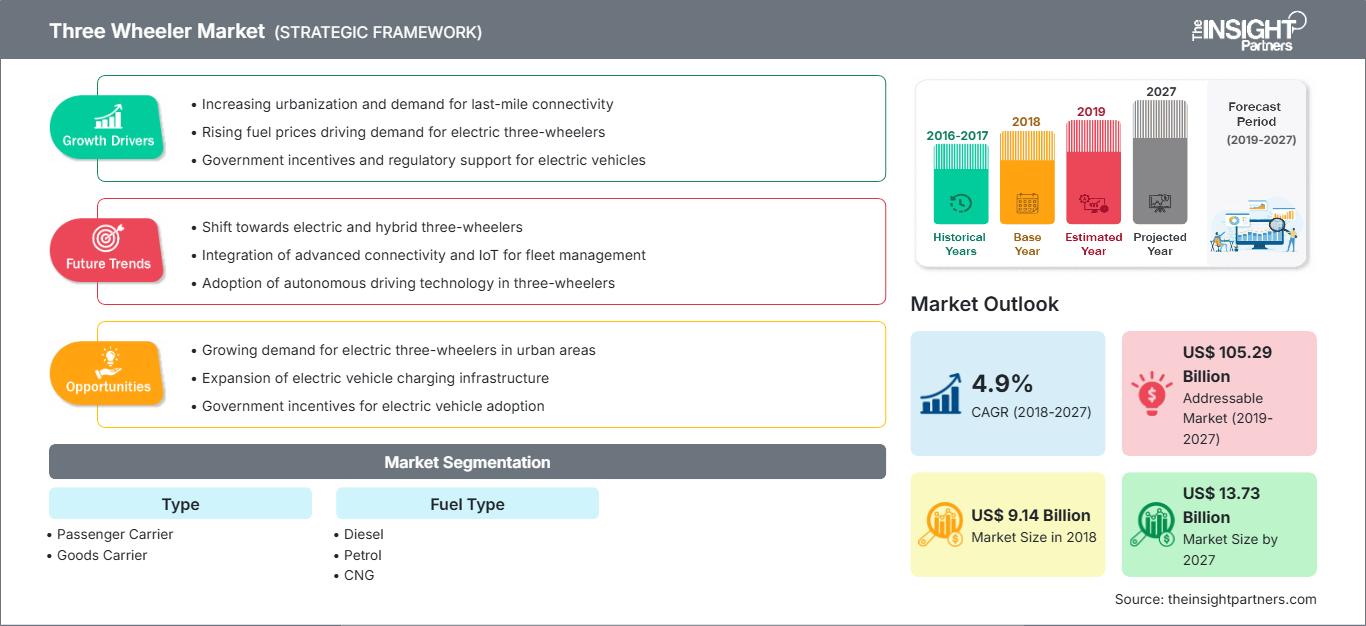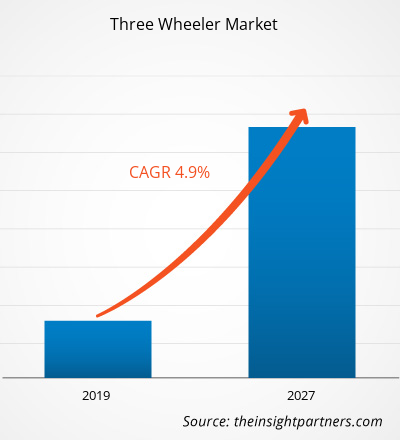삼륜차 시장은 2018년 91억 4천만 달러 규모였으며, 2019년부터 2027년까지 연평균 성장률 4.9%로 성장하여 2027년에는 137억 3천만 달러에 이를 것으로 예상됩니다.
삼륜차는 승객 운송에 사용되는 삼륜차입니다. 삼륜차는 최소 3명에서 최대 5~6명의 승객을 태울 수 있습니다. 시골 지역에서는 필요에 따라 6명 이상의 승객이 삼륜차로 이동합니다. 전기 인력거는 삼륜차의 주요 유형 중 하나입니다. 전기 인력거는 배터리로 구동되는 친환경 차량으로, 기존 삼륜차에 비해 배기가스가 적고 소음이 적습니다. 전기 인력거는 5~6명의 승객을 태울 수 있습니다. 전기 삼륜차 수요 증가, 인구 증가, 그리고 해당 지역의 교통 체증 해소에 도움이 되는 차량에 대한 수요 증가는 세계 삼륜차 시장의 성장을 촉진해 왔습니다. 2018년 아시아 태평양 지역은 예측 기간 동안 삼륜차 시장에서 중요한 위치를 차지할 것으로 예상됩니다. 인도와 같은 국가들은 예측 기간 동안 국내 및 수출 시장을 장악할 것으로 예상됩니다. 또한, 인도의 많은 기존 업체들은 미세먼지, 질소산화물, 황 배출을 억제하기 위해 2020년까지 시행될 예정인 BS(Bharat Stage) VI 규정을 준수하는 삼륜차 생산에 집중하고 있습니다. 중국을 필두로 태국, 말레이시아 등 다른 아시아 국가들도 농촌 및 준도시 지역의 교통 수단 수요 증가와 인구 증가로 인해 상당한 성장세를 보이고 있습니다.
이 보고서의 일부, 국가 수준 분석, Excel 데이터 팩을 포함하여 모든 보고서에 대한 사용자 정의를 무료로 받을 수 있을 뿐만 아니라 스타트업 및 대학을 위한 훌륭한 제안 및 할인을 이용할 수 있습니다
삼륜차 시장: 전략적 통찰력

-
이 보고서의 주요 주요 시장 동향을 확인하세요.이 무료 샘플에는 시장 동향부터 추정 및 예측에 이르기까지 데이터 분석이 포함됩니다.
전 세계 자동차 산업은 여러 신규 삼륜차 제조업체의 수가 꾸준히 증가하고 있습니다. 삼륜차 제조업체는 전기 삼륜차 부문이 전 세계적으로 고객의 관심을 끌고 있기 때문에 이 부문의 개발에 지속적으로 주목하고 있습니다. 글로벌 자동차 산업은 기존 삼륜차에서 전기 삼륜차로의 상당한 전환을 경험하고 있습니다.
다양한 국가의 정부가 전기 삼륜차 도입을 위한 주도권을 잡고 있습니다. 예를 들어, 2018년 3월, 인도 중공업 및 공기업부는 향후 3년간 2019년 4월 1일에 시작된 FAME 인도 계획의 2단계를 시작했으며 총 예산 지원은 13억 9천만 달러입니다. 이 단계는 주로 공공 및 공공 서비스의 전기화를 지원하기 위해 시작되었습니다. 영어: 공유 교통을 목표로 하고 보조금을 통해 7,000대의 전기 버스, 50만 대의 전기 3륜차, 55,000대의 전기 4륜 승용차, 100만 대의 전기 2륜차를 지원하는 것을 목표로 합니다. FAME 계획의 이 단계에서는 EV 사용자의 신뢰를 얻기 위해 적절한 공공 충전 인프라를 구축하기를 기대합니다. 이를 통해 중공업 및 공기업부는 산업, 공공 부문 기업(PSE), 정부 기관을 포함한 다양한 이해 관계자의 참여와 적극적인 참여를 기대하고 있습니다. 시장의 주요 업체는 전기 자동차 개발을 목표로 하고 있습니다. 예를 들어, Piaggio & C. SpA와 이탈리아 자동차 제조업체는 Piaggio Ape Electrik Electric 3륜차 제품군에 Piaggio Ape E-City를 출시했습니다. E-auto에는 교체 가능한 리튬 이온 배터리가 함께 제공되며 한 번 충전하면 약 70-80km의 범위를 커버할 수 있습니다. 또한, 2019년 8월, Euler Motors는 2020년 초 인도에서 전기 삼륜 경상용 화물차를 출시할 것이라고 발표했습니다. 인도와 중국에는 수많은 삼륜차 제조업체가 있으며, 전기 삼륜차의 수용도 매년 빠른 속도로 증가하고 있습니다. 인도와 중국 외에도 브라질, 아르헨티나와 같은 남미 국가들과 남아프리카공화국, 나이지리아, 이집트와 같은 중동 및 아프리카 국가들도 자동차 산업에서 전기 삼륜차 도입이 빠르게 확대되고 있습니다. 아시아 태평양 지역은 자동차 산업을 주도해 왔으며, 큰 성장을 목격하고 있습니다. 그럼에도 불구하고, 이 지역에서 사업을 펼치는 자동차 기업들은 전기 삼륜차 보급을 기하급수적으로 확대하기 위해 부품 공급업체와의 파트너십을 더욱 강화해야 합니다. 다른 시장 참여자들과의 전략적 파트너십, 협력, 계약, 인수는 업계 참여자들이 시장을 주도하는 주요 요인이며, 이는 향후 몇 년 동안 전 세계 삼륜차 시장을 견인할 것으로 예상됩니다.
유형별 통찰
유형별로 보면, 여객 운송업체가 세계 삼륜차 시장에서 가장 큰 점유율을 차지했습니다. 여객 운송업체는 다양한 민간 운송업체와 운송업에 종사하는 개인이 구매할 수 있는 가장 저렴한 운송 수단입니다. 이 부문의 성장은 적절한 도로 부족, 부적절한 교통 시설, 교통 체증이 심한 도시 지역 등 저비용 여객 운송업체에 대한 수요 증가에 힘입은 것입니다.
연료 유형별 통찰
삼륜차 시장은 연료 유형에 따라 디젤, 휘발유, CNG, LPG, 전기로 구분됩니다. 휘발유 부문은 세계 삼륜차 시장에서 지배적인 점유율을 차지했습니다.
주도권은 기업들이 전 세계로 사업을 확장하고 증가하는 고객 수요를 충족하기 위해 채택하는 전략입니다. 삼륜차 시장의 주요 업체들은 주로 고급 기능과 기술을 통합하여 제품 및 서비스 개선에 주력하고 있습니다. 기업들은 파트너십, 계약, 합작 투자 체결, 그리고 전 세계에 새로운 지사 설립을 통해 시장 점유율과 브랜드 인지도를 확대하고자 노력하고 있습니다. 대부분의 시장 활동은 미래 시장 성장 잠재력이 높은 아시아 태평양 지역에서 이루어졌습니다. 그중 몇 가지를 아래에 소개합니다.
2019년: 2019년 12월, Greaves Cotton은 TVS Motor Company와의 파트너십을 발표했습니다. 이 파트너십을 통해 Greaves Cotton은 인도에서 TVS Motor의 삼륜차 공식 서비스 센터 역할을 수행하게 됩니다. 2018년: ATUL Auto Limited는 인도에 본사를 둔 자동차 부품 회사인 JBM Industries와 파트너십을 맺었습니다. JBM Industries는 삼륜차 전기 자동차 사업을 확장하기 위해 파트너십을 체결했습니다.
삼륜차 시장The Insight Partners의 분석가들은 예측 기간 동안 삼륜차 시장에 영향을 미치는 지역별 동향과 요인들을 면밀히 분석했습니다. 이 섹션에서는 북미, 유럽, 아시아 태평양, 중동 및 아프리카, 그리고 중남미 지역의 삼륜차 시장 세분화 및 지역별 분포도 살펴봅니다.
삼륜차 시장 보고서 범위
| 보고서 속성 | 세부 |
|---|---|
| 시장 규모 2018 | US$ 9.14 Billion |
| 시장규모별 2027 | US$ 13.73 Billion |
| 글로벌 CAGR (2018 - 2027) | 4.9% |
| 이전 데이터 | 2016-2017 |
| 예측 기간 | 2019-2027 |
| 다루는 세그먼트 |
By 유형
|
| 포함된 지역 및 국가 |
북미
|
| 시장 선도 기업 및 주요 회사 프로필 |
|
삼륜차 시장 참여자 밀도: 비즈니스 역학에 미치는 영향 이해
삼륜차 시장은 소비자 선호도 변화, 기술 발전, 그리고 제품 이점에 대한 인식 제고 등의 요인으로 인해 최종 사용자 수요가 증가함에 따라 빠르게 성장하고 있습니다. 수요가 증가함에 따라 기업들은 제품 라인업을 확장하고, 소비자 니즈를 충족하기 위한 혁신을 추진하며, 새로운 트렌드를 적극 활용하고 있으며, 이는 시장 성장을 더욱 가속화하고 있습니다.

- 을 얻으세요 삼륜차 시장 주요 주요 플레이어 개요
- 승객 운송업체
- 화물 운송업체
삼륜차 시장 - 연료 유형별
- 디젤
- 휘발유
- CNG
- LPG
- 전기
지역별 글로벌 삼륜차 시장
-
북미
- 미국
- 캐나다
- 멕시코
-
유럽
- 프랑스
- 독일
- 이탈리아
- 영국
- 러시아
- 기타 유럽
-
아시아 태평양
- 중국
- 인도
- 한국
- 일본
- 호주
- 기타 아시아 태평양
-
기타 세계
- 아프리카
- 라틴 아메리카
회사 프로필
- ATUL Auto Limited
- Bajaj Auto Ltd.
- JS AUTO (P) LTD.
- Mahindra & Mahindra Ltd.
- Piaggio & C. SpA
- Scooters India Limited
- Speego Vehicles Co Pvt Limited
- Terra Motors Corporation
- TVS Motor Company
- Xianghe Qiangsheng 전기 삼륜차 공장
- 과거 분석(2년), 기준 연도, CAGR을 포함한 예측(7년)
- PEST 및 SWOT 분석
- 시장 규모 가치/거래량 - 글로벌, 지역, 국가
- 산업 및 경쟁 환경
- Excel 데이터세트
최근 보고서
관련 보고서
사용 후기
구매 이유
- 정보에 기반한 의사 결정
- 시장 역학 이해
- 경쟁 분석
- 고객 인사이트
- 시장 예측
- 위험 완화
- 전략 기획
- 투자 타당성 분석
- 신흥 시장 파악
- 마케팅 전략 강화
- 운영 효율성 향상
- 규제 동향에 발맞춰 대응






















 무료 샘플 받기 - 삼륜차 시장
무료 샘플 받기 - 삼륜차 시장